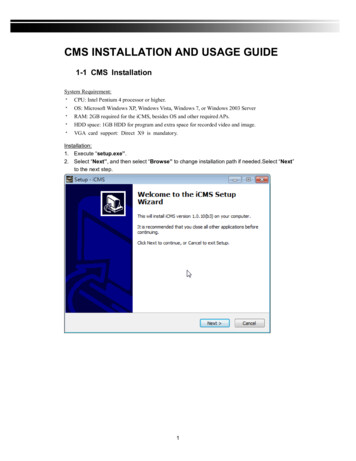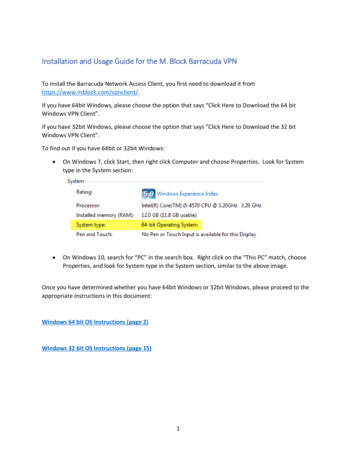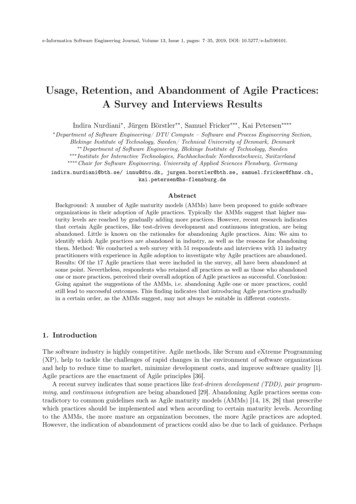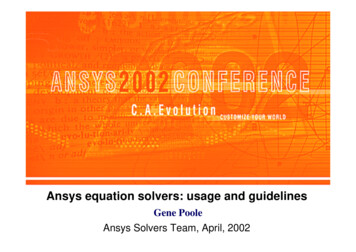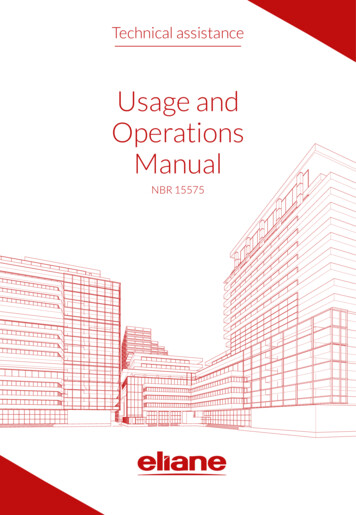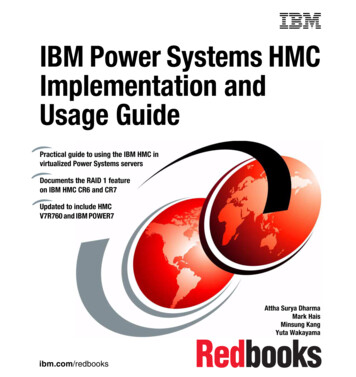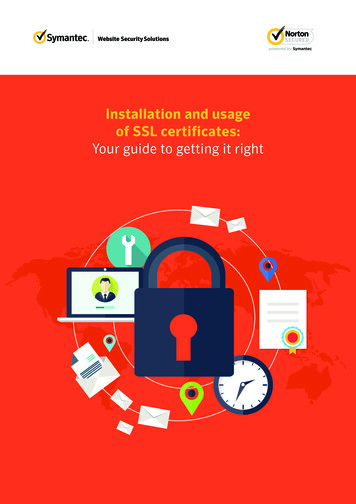
Transcription
Installation and usageof SSL certificates:Your guide to getting it right
So, you’ve bought your SSL Certificate(s).Buying your certificate is only the first of many steps involved in securing your website. All too often,certificates are not properly installed, sensitive pages are left insecure, and form information postedunencrypted, leaving many websites vulnerable to attack.That is why Symantec has put together the following tips, as your guidance to getting the process absolutelyright from the outset. Steering you through the more stormy waters, warning you off the more turbulentpractices and procedures that can undermine SSL, because your SSL Certificate is the passport to a safer,more secure site for you, your people and your customers.Only one way to install SSL – and that’s properly!Like many other organisations, you’ve recognised the need to purchase an SSL Certificate and taken that allimportant step. Now you need to make sure it is properly installed. If your customers don’t feel completelysafe on your site, they simply will not do business with you.2 I Symantec CorporationInstallation and usage of SSL certificates: Your guide to getting it right.
TIP 1 - Preparing the Private Key and CSRTo install a digital certificate, you must first generate the private key andthe Certificate Signing Request (CSR) from that private key, for theserver where the certificate will be installed. Then submit the CSR toenrol for a certificate. Here’s how.If you have IIS 6 and above servers or Redhat Linux servers you can download our tool – Symantec SSLAssistant – and follow the user-friendly prompts. For a list of CSR generation instructions on other servers,have a look at: Symantec CSR Generation. To enrol for any of Symantec’s SSL Certificate services, you willneed the following information: The term or validity period of the certificate, 1, 2 or 3 yearsThe number of servers hosting a single domain (up to 5 servers)The server platformThe organisation, organisational unit, addressPayment information and a contact for invoicingThe common name. This is the host domain name, such as ‘www.mydomain.com’ or ’webmail.mydomain.com’An email address where Symantec can reach you to validate the informationA Certificate Signing Request (CSR) generated from the server you need to secureThen, once you get your certificate, follow the instructions in tip 3.If your server is not listed or you need additional information, refer to your server documentation or contactyour server vendor. If you do not know what software your server uses, contact your IT administrators.During enrolment, submit the CSR with the header and footer:-----BEGIN CERTIFICATE SIGNING REQUEST----XXXXXXXX-----END CERTIFICATE SIGNING REQUEST-----3 I Symantec CorporationInstallation and usage of SSL certificates: Your guide to getting it right.
TIP 2 - How to install an SSL Certificate – the Right Way!About to install an SSL Certificate for the first time and finding theidea a bit intimidating? You needn’t worry. It’s much easier than youmight think. Let’s have a look at installing a Certificate on a server,with Symantec.All servers follow the same logic:Step 1 – Saving the CertificateFollow the instructions in your confirmation email to save the SSL Certificate to your desktop from the URLprovided. That will give you both your Certificate and the intermediate CA Certificates you need.Step 2 – Install or move to a Certificate folderStep 3 – Configure the Certificate on the websiteStep 4 – Reference the CertificateClick here for detailed information and step by step instructions for each server type.To get the most out of your SSL Certificate, be sure to add the Norton Secured Seal to your website. That willmake your customers feel more secure when transacting with you.Just copy and paste the relevant lines from Symantec’s Norton Secured Seal pages to add the seal on yourwebsite – clear instructions will be found in the link at the end of this tip. This will also explain how you cantest your Certificate with the Certificate Installation Checker by entering your domain when prompted.Now your SSL Certificate is installed – and ready to roll!Having problems?Symantec has a range of tutorial videos for different servers: View TutorialsCheck Your InstallationJust enter the URL of the server you want to check: Check InstallationGenerate Your Site SealNorton Secured Seal Installation Instructions: Generate SealTroubleshootingVisit Symantec Support site: Access Support4 I Symantec CorporationInstallation and usage of SSL certificates: Your guide to getting it right.
TIP 3 - Protect Your Private Keys – and Opt for the BestPublic and private keys are an integral part of how SSL works.The private key is kept secret on your server and is used to encrypteverything on the website. The public key placed inside the certificateis yet another part of your website’s identity, such as your domainname and organisation details.Treat your private keys as priceless assets, shared only amongst the minimum number of most trustedassociates or employees. Imagine that you are a bank manager: would you hand out the keys to the vaultindiscriminately? No. So here are some best practice tips: Generate private keys on a trusted server. Do not hand this task over to a third party! Password-protect the private keys to prevent any compromise when they are stored in backup systems. Renew certificates every year – and always introduce new private keys at the same time.The size of the private key exerts a great deal of influence on the cryptographic ‘handshake’ used toestablish secure connections. Using a key that is too short is insecure, but using a key that’s too long canseriously slow down operations.Elliptic Curve Cryptography (ECC) is gaining increasing attention, providing strong security assurances atsmaller key lengths. Symantec offers ECC with key sizes at a fraction of the number of bits that RSA and DSArequire, yet is over 10,000 times harder to crack (256-bits for ECC is the equivalent cryptographic strengthof 3072-bits RSA). ECC offers stronger security with much reduced server overhead and will help to reduceCPU cycles required for server cryptographic operations.More information on ECC is available on Page 7.5 I Symantec CorporationInstallation and usage of SSL certificates: Your guide to getting it right.
TIP 4 - Eliminate Any Weak Leaks in the ChainIn most SSL deployments, the server certificate alone is insufficient:three or more certificates are needed to establish a complete chain oftrust. A certificate chain consists of all the certificates needed to certifythe subject identified by the end certificate.In practice this chain includes the end entity certificate, the intermediate CA certificates and the rootCA certificate.The process of verifying the authenticity and validity of a newly received certificate involves checking all ofthe certificates from the universally trusted Root CA, through any intermediate CAs, down to the certificatejust received – the ‘end entity certificate’. A certificate can only be trusted if each certificate in thatcertificate’s chain has been properly issued and validated.A common problem is configuring the end entity certificate correctly, but forgetting to include the intermediate CA certificates. To check if the intermediates are installed properly use our certificate checker.6 I Symantec CorporationInstallation and usage of SSL certificates: Your guide to getting it right.
TIP 5 - RSA, ECC and Why Key Length is ImportantElliptic Curve Cryptography (ECC) offers your business enhancedsecurity and better performance than current encryption.A US government-approved and National Security Agency-endorsed encryption method, ECC createsencryption keys based on the idea of using points on an elliptic curve to define the public/private key pair.It is difficult to break using the brute force methods often employed by hackers and offers a faster solutionwith less computing power than RSA-based encryption.RSA is an encryption and digital signature algorithm that has been the basis for security on the internet fornearly two decades. It is still a valid algorithm to use, but the acceptable minimum key size has increasedwith time to ensure protection from improved cryptographic attacks. Thus, with ECC, you get betterperformance, because it requires a shorter key length and provides a superior level of security. For instance,a 256-bit ECC key provides the same level of protection as a 3072-bit RSA key. The result? You get preciselythe security you need without sacrificing performance.Moreover, ECC’s smaller key length means smaller certificates that consume less bandwidth. As more ofyour customers move to smaller devices for their online transactions, ECC offers a better all-round customerexperience.Symantec’s ECC roots have been available in the top three browsers since 2007, so Symantec’s ECCcertificates will work in your existing infrastructure, as long as modern browsers are used, and they areavailable at no additional cost.Learn more about ECC and Algorithm Agility.7 I Symantec CorporationInstallation and usage of SSL certificates: Your guide to getting it right.
TIP 6 - All-embracing ‘Always On SSL’You should always look to encrypt your whole website with SSL –and the way to do that is to use Always On SSL. This is a cost-effectivesecurity measure for websites that helps protect the entire userexperience from start to finish, making it safer to search, share andshop online.Companies that are truly serious about protecting their customers and their business reputation willimplement Always On SSL with SSL certificates from a trusted Certificate Authority, such as Symantec.Always On SSL is easy to implement, delivering authentication of the identity of the website and encryptingall information shared between the website and a user (including any cookies exchanged), protecting thedata from unauthorised viewing, tampering or use.Significantly, the Online Trust Alliance is calling for websites to adopt Always On SSL. It advises “Always OnSSL is a proven, practical security measure that should be implemented on all websites where users share orview sensitive information”.Many of the world’s most successful websites have recognised the wisdom of successfully implementingAlways On SSL, protecting themselves against sidejacking and hacking through threats such as Firesheepand malicious code injection.Always On SSL can help you protect the trust that users have invested in your website, giving users theassurance of knowing that you take their security and privacy seriously – and that you are taking everypossible step to protect them online.8 I Symantec CorporationInstallation and usage of SSL certificates: Your guide to getting it right.
TIP 7 - Public Key Pinning: a Matter of TrustPublic key pinning (more properly known as the Public Key PinningExtension for HTTP) is designed to give website operators the meansto restrict which certificate authorities can issue certificates fortheir servers.Basically, public key pinning associates a host with their expected certificate or public key. Once a public keyis known or seen for a host, the public key is associated or ‘pinned’ to that host.According to the CA Security Council, public key pinning allows the website owner to make a statement thatits SSL certificate must have one or more of the following: A specified public key Signed by a CA with this public key Hierarchical-trust to a CA with this public keyIf a certificate for the website owner’s domain is issued by a CA that is not listed (ie, not pinned), then abrowser that supports public key pinning will provide a trust dialogue warning. Website owners can also pinmultiple keys from multiple CAs and all will be treated as valid by the browsers.The website owner trusts that the chosen CAs will not mistakenly issue a certificate for the owner’s domain.These CAs often restrict who can request the issuance of a certificate for the owner’s specific domains,which provides additional security against certificates being wrongly issued to an unauthorised party.Unfortunately, the CA Security Council states that the public key pinning that Google implemented in 2011 isnot scalable as it requires the public keys for each domain to be added to the browser. A new, scalable publickey pinning solution is being documented through a proposed IETF RFC (Internet Engineering Task ForceRequest for Comments).In this proposal, the public key pins will be defined through an HTTP header from the server to the browser.The header options may contain a SHA-1 and/or SHA-256 key algorithm, maximum age of pin, whether itsupports sub-domains and the strictness of the pinning, for example.9 I Symantec CorporationInstallation and usage of SSL certificates: Your guide to getting it right.
TIP 8 - Drive off the Eavesdroppers with Perfect Forward SecrecyWould you be happy to think that an eavesdropper who was busyrecording traffic – your traffic – here and now might be able to decryptthat in the future? No, of course not. And yet that could be the situationyour organisation finds itself, albeit totally unaware of this danger.Take RSA, for example. It generates a public and private key to encrypt and decode messages. Yet thecontinued use of recoverable keys could make stored encrypted data accessible, if keys are compromised inthe future. In many cases, an attacker with your private key and saved SSL traffic can use the private key todecrypt all session keys negotiated during saved SSL handshakes, and then decrypt all saved session datausing those session keys. It’s a scenario that doesn’t make for sleep-filled nights. But there’s a better way –and it’s called ‘Perfect Forward Secrecy’.When you use this solution, unrecoverable temporary session keys are generated, used and discarded.Moreover, PFS, when implemented correctly with Elliptical Curve Cryptography (ECC – see Tip 5), is moresecure than RSA algorithms and performs better.Using PFS, there is no link between the server’s private key and each session key. If both client and serversupport PFS, they use a variant of a protocol named Diffie-Hellman (after its inventors), in which both sidessecurely exchange random numbers and arrive at the same shared secret. It’s a clever algorithm thatprevents an eavesdropper from deriving the same secret, even if the eavesdropper can view all the traffic.For more details, see this Symantec Infographic:View Infographic10 I Symantec CorporationInstallation and usage of SSL certificates: Your guide to getting it right.
TIP 9 - HTTP Strict Transport Security: your safety netStaying ultra-safe online is vital. And sometimes that means ‘going theextra mile’ – beyond standard security – to get to where you want to be.Hackers can make use of man-in-the-middle attacks, over wireless networks, such as SSL stripping to interceptbrowser requests to HTTPS sites and serve back requested pages over HTTP. This means that the connectionis no longer encrypted and the hacker can intercept information that the victim enters into the supposedlysecure website. The victim may never notice the change as they aren’t paying close attention to the browseraddress bar every time they navigate to a new page on a website. Browsers have no way of knowing thata website should be delivered securely, so will not alert you when a website is loaded via an unencryptedconnection.HTTP Strict Transport Security (HSTS) prevents this from happening by allowing servers to send a messageto the browser demanding that any such connection must be encrypted. The browsers then acts on thatmessage, so every web page that your customer visits will be encrypted as intended. Safeguarding youand your customers from attack.To activate HSTS protection, you set a single response header in your websites. After that, browsers thatsupport HSTS (Chromium, Google Chrome, Firefox, Opera, Safari for example) will respect your instructions.After activation, HSTS does not allow insecure communication with your website. It achieves this byautomatically converting all plain-text links to secure ones.Internet Explorer does not yet support HSTS, but Microsoft has stated that it will do so in InternetExplorer 12.11 I Symantec CorporationInstallation and usage of SSL certificates: Your guide to getting it right.
Copyright 2015 Symantec Corporation. All rightsreserved. Symantec, the Symantec Logo, the CheckmarkCircle Logo and the Norton Secured Logo are trademarksor registered trademarks of SymantecCorporation or its affiliates in the U.S. and othercountries. Other names may be trademarks of theirrespective owners.Installation and usage of SSL certificates: Your guide to getting it right.
2 I Symantec Corporation Installation and usage of SSL certificates: Your guide to getting it right. So, you’ve bought your SSL Certificate(s). Buying your certificate is only the first of man
